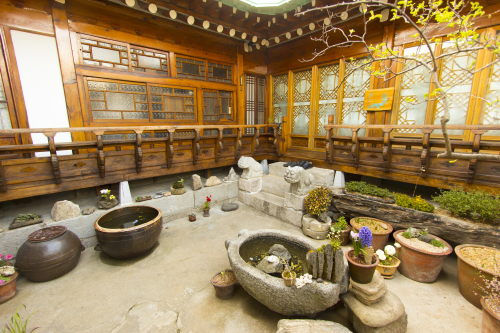What should a hanok sound like? A high-tech interactive music piece composed for one such traditional Korean home in Seoul’s hanok district may have the answer.
“NOKHA,” an anagram of “hanok,” is a 50-minute composition for flute, violin, toy piano and geomungo, a traditional Korean instrument. But this work is not bound by a fixed score. Rather, the music is shaped by the audience, whose movements are captured on camera and relayed to the performers in real-time via iPad.
“The concept of the show is that of interaction,” explained Shin Jee-soo, the composer behind the work. “Everyone in the scene is equally important in that they take part in the making of the music they hear.”
The idea came about as a result of a conversation between Shin and long-time hanok activist David Kilburn at a meeting of the Korean Artists Association in London last November.
“NOKHA,” an anagram of “hanok,” is a 50-minute composition for flute, violin, toy piano and geomungo, a traditional Korean instrument. But this work is not bound by a fixed score. Rather, the music is shaped by the audience, whose movements are captured on camera and relayed to the performers in real-time via iPad.
“The concept of the show is that of interaction,” explained Shin Jee-soo, the composer behind the work. “Everyone in the scene is equally important in that they take part in the making of the music they hear.”
The idea came about as a result of a conversation between Shin and long-time hanok activist David Kilburn at a meeting of the Korean Artists Association in London last November.

“During (Shin’s) talk, she mentioned that she was very interested in the interactions of music and architecture,” explained Kilburn, a 25-year resident of Korea originally from the U.K.
“I then asked her if she would be interested in creating a piece of music specifically for a hanok, i.e. my hanok in Gahoe-dong. She thought this was an interesting idea, and so the project was born.”
The opening performance at Kilburn’s own hanok in Bukchon will be followed by performances at hanok in Jeonju and Hamyang.
“Since all traditional hanok share some common features, it then proved not too difficult to embrace performances in Jeonju and Hamyang when people there became interested in the concept,” said Kilburn.
For Shin as an artist, the traditional Korean home provides an ideal venue for breaking down the barriers between performer and audience.
“I thought hanok was a wonderful venue of conveying the idea of interweaving roles of the audience and performer because a traditional hanok has no concrete boundary between ‘indoors’ and ‘outdoors,’ thus giving less of a boundary between the stage and the audience,” said Shin.
Shin hopes that her work can help make contemporary music more accessible to those who would otherwise by intimidated by creating an informal, “gallery-like” atmosphere.
“I suspect that the reason contemporary music is not as popular as contemporary art is because in concerts, they feel trapped in their seats which might create some adverse reactions. I thought, this need not be in music performances either. My event thus creates a gallery-like environment where the ‘audience’ can leave the venue whenever they want,” she said.
For Kilburn, long a campaigner for the preservation of Korean architecture, the musical event is also an opportunity to highlight just what makes hanok so special.
“I would hope the audience leaves with a fresh appreciation of the cultural values of hanoks and also of the cutting edge work of a talented young Korean composer,” he said.
NOKHA will be performed on April 21 at Gahoe-dong 31-79, Seoul at 7 p.m.; May 11 at the Saehwa-gwan at Jeonju Hanok Living Experience Center in North Jeolla Province; and May 12 at 263-1 Gaepyeong-ri, Jigok-myeon, Hamyang, South Gyeongsang Province. All performances begin at 7 p.m. and are free, with more to be announced. For more information on NOKHA, visit www.nokha.org.
By John Power (john.power@heraldcorp.com)
-
Articles by Korea Herald


![[Weekender] Geeks have never been so chic in Korea](http://res.heraldm.com/phpwas/restmb_idxmake.php?idx=644&simg=/content/image/2024/05/16/20240516050845_0.jpg&u=)


![[News Focus] Mystery deepens after hundreds of cat deaths in S. Korea](http://res.heraldm.com/phpwas/restmb_idxmake.php?idx=644&simg=/content/image/2024/05/17/20240517050800_0.jpg&u=)

![[KH Explains] Why Korea's so tough on short selling](http://res.heraldm.com/phpwas/restmb_idxmake.php?idx=644&simg=/content/image/2024/05/19/20240519050115_0.jpg&u=20240519162247)

![[Herald Interview] Byun Yo-han's 'unlikable' character is result of calculated acting](http://res.heraldm.com/phpwas/restmb_idxmake.php?idx=644&simg=/content/image/2024/05/16/20240516050855_0.jpg&u=)









